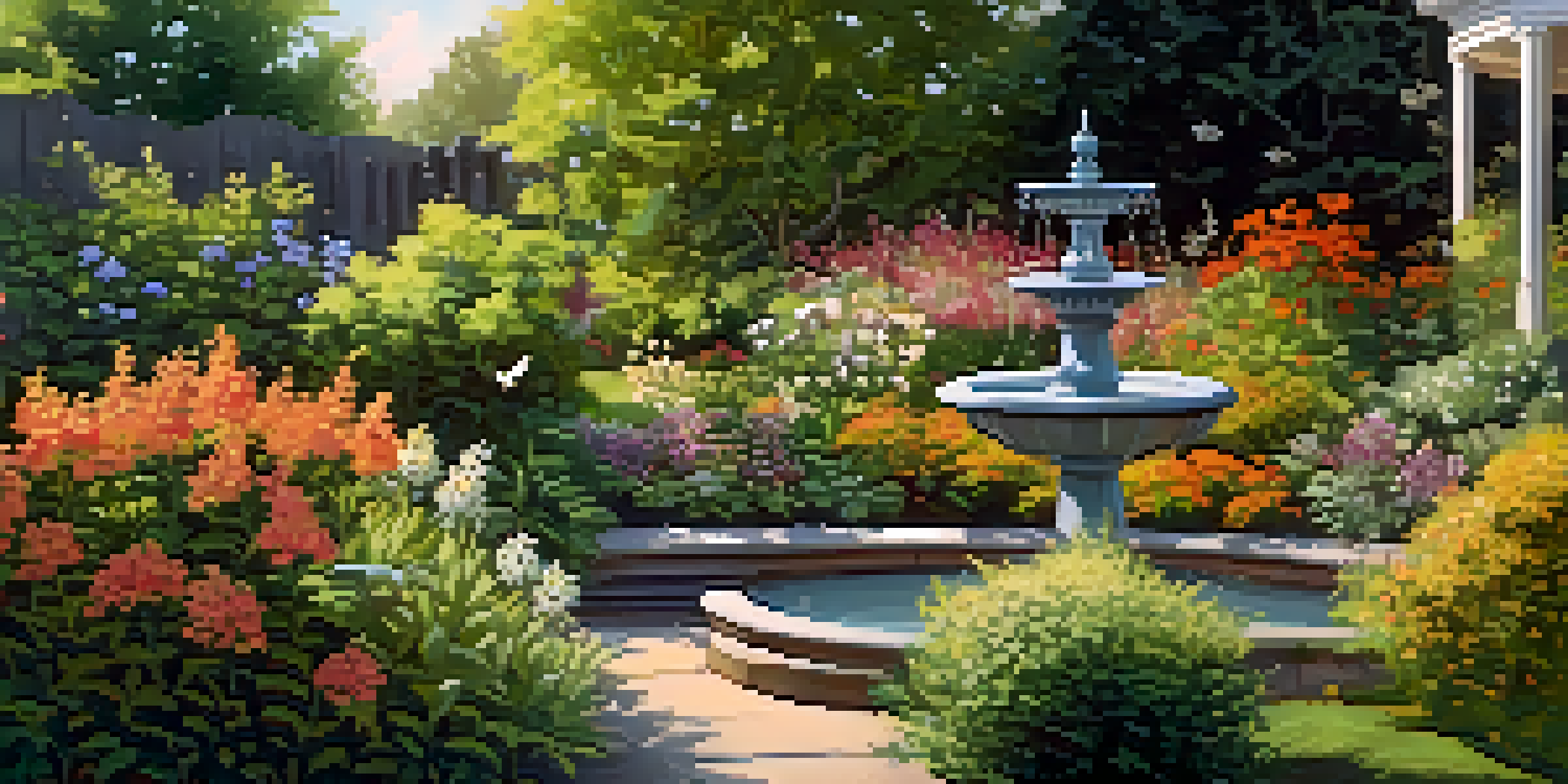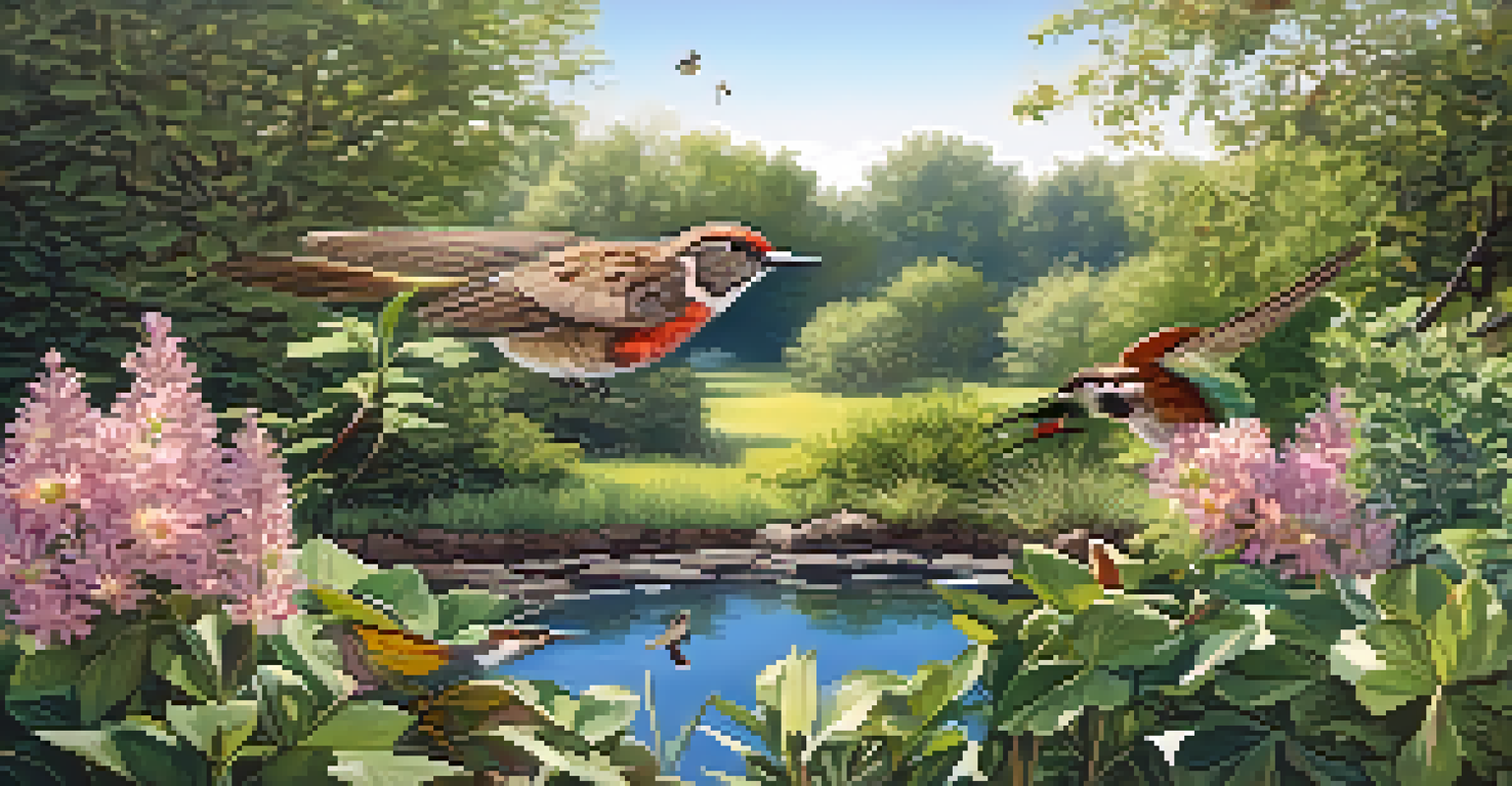Gardening with Native Shrubs: Attracting Local Wildlife

Understanding Native Shrubs and Their Importance
Native shrubs are plants that naturally grow in a specific region, adapting beautifully to local climates and soils. By incorporating these shrubs into your garden, you create a welcoming environment for local wildlife, including birds, bees, and butterflies. These plants provide essential habitats and food sources that support the delicate balance of your local ecosystem.
The greatest threat to our planet is the belief that someone else will save it.
For instance, when you plant native shrubs like elderberry or serviceberry, you’re not just beautifying your space; you’re offering sustenance to pollinators and fruit-eating birds. This symbiotic relationship enhances biodiversity, which is vital for the health of our planet. Additionally, native shrubs typically require less maintenance and are more resilient to pests and diseases, making them an eco-friendly choice for gardeners.
By choosing to garden with native shrubs, you contribute to the conservation of local flora and fauna. This choice helps maintain the natural heritage of your area, providing a meaningful connection to your landscape. So, let’s explore how to start cultivating these beneficial plants in your garden!
Choosing the Right Native Shrubs for Your Region
Selecting the right native shrubs begins with understanding your local climate, soil type, and ecological zones. Each region boasts its own unique set of native plants that thrive in those specific conditions. For example, if you live in the Southeastern U.S., you might consider planting azaleas or wax myrtles, which are well-suited for that environment.

You can often find resources through local nurseries, botanical gardens, or extension offices that provide lists of native shrubs ideal for your area. These experts can also guide you in understanding the specific needs of each plant, such as sunlight requirements and water needs. Knowing what will thrive in your garden ensures that you’re making choices that support both your gardening goals and local wildlife.
Native Shrubs Support Local Wildlife
Planting native shrubs creates essential habitats and food sources for local birds, bees, and butterflies, enhancing biodiversity.
Additionally, consider incorporating a variety of shrubs that bloom at different times throughout the year. This strategy ensures that food sources are available for wildlife in all seasons, helping to create a vibrant and dynamic ecosystem right in your backyard. The more diverse your plant selection, the more wildlife you’ll attract!
Creating an Inviting Habitat for Wildlife
When designing your garden with native shrubs, think about how you can create a habitat that is not only beautiful but also functional for wildlife. Grouping shrubs in clusters can provide shelter and foraging opportunities for birds and small mammals. This arrangement mimics natural patterns found in the wild, making it easier for wildlife to find food and refuge.
Nature does not hurry, yet everything is accomplished.
Incorporating layers of native shrubs, along with other plant types like grasses and flowers, enhances the habitat’s complexity. This layering creates various niches, allowing different species to thrive. For example, hummingbirds might be attracted to flowering shrubs while larger birds prefer denser, shrubby areas for nesting.
Don't forget about water sources! A small birdbath or a pond can be a fantastic addition to your garden. It not only supports wildlife but also adds an element of tranquility to your outdoor space. By focusing on creating a welcoming habitat, you’ll invite a delightful array of creatures to visit your garden.
Best Native Shrubs to Attract Birds
Birds are often the most visible wildlife visitors in our gardens, and native shrubs can play a pivotal role in attracting them. Shrubs like elderberry, viburnum, and chokecherry provide both cover and food. These plants produce berries that are a favorite for many bird species, making your garden an appealing stopover.
In addition to providing food, native shrubs offer critical nesting sites. Birds such as sparrows and warblers prefer dense foliage for protection while raising their young. By planting native shrubs, you create a safe haven where these birds can thrive and reproduce, contributing to local biodiversity.
Choose Shrubs for Your Climate
Selecting the right native shrubs based on your local climate and soil conditions ensures they thrive and support local ecosystems.
Moreover, the presence of birds can help control pests naturally, making your garden healthier overall. Imagine the joy of watching colorful birds flitting from branch to branch while you enjoy your outdoor space. It's a win-win situation for both you and our feathered friends!
Attracting Pollinators with Native Shrubs
Pollinators like bees, butterflies, and hummingbirds are essential for the health of our ecosystems, and native shrubs can greatly enhance their presence in your garden. Many native shrubs produce vibrant flowers that are specifically adapted to attract these beneficial insects. For instance, plants like buttonbush and beautyberry are excellent choices for drawing in butterflies and bees.
By providing a continuous supply of nectar and pollen throughout the growing season, you can create a pollinator-friendly garden. Selecting shrubs with staggered bloom times ensures that food sources are available from spring through fall. This not only helps individual pollinator species but also supports the overall health of the ecosystem.
In addition to food, native shrubs offer shelter for pollinators, allowing them to rest and nest. The more you can do to support these creatures, the healthier your garden will become. Creating a pollinator haven is not just beneficial for wildlife; it also promotes a vibrant and productive garden!
Maintaining Your Native Shrub Garden
Caring for your native shrub garden is relatively straightforward, thanks to their hardiness and adaptability. However, some basic maintenance practices can help ensure your shrubs thrive. Regularly checking for pests and diseases is essential, though native plants are generally less prone to these issues than non-natives.
Watering is another important aspect, especially during the establishment phase. Once your native shrubs are established, they will often require less water than non-native varieties. Mulching can also help retain moisture and suppress weeds, creating a healthier environment for your plants.
Gardening with Native Shrubs is Easy
Native shrubs require less maintenance and are more resilient, making them a sustainable choice for gardeners looking to connect with nature.
Lastly, don’t be afraid to prune your shrubs as needed. Pruning helps maintain their shape and encourages new growth. Plus, it can be an opportunity to observe how your plants are interacting with local wildlife, providing a rewarding connection between your gardening efforts and the natural world.
The Joy of Gardening with Native Shrubs
Gardening with native shrubs not only benefits local wildlife but also offers a rewarding experience for you as a gardener. Watching your garden flourish and attract various species is a source of joy and pride. It connects you to nature and allows you to witness the beauty of biodiversity in action.
Moreover, native shrubs often require less work than non-native plants, freeing up your time to enjoy other aspects of your garden. You’ll find that these plants tend to be more resilient, leading to less frustration and more satisfaction as you watch them thrive. Gardening becomes a more enjoyable and fulfilling hobby when you work with nature rather than against it.

As you cultivate your native shrub garden, you’re participating in a larger movement toward sustainability and ecological responsibility. You’re not just creating a beautiful space; you’re contributing to the health of your local environment. So grab your gardening gloves and get started—your local wildlife will thank you!